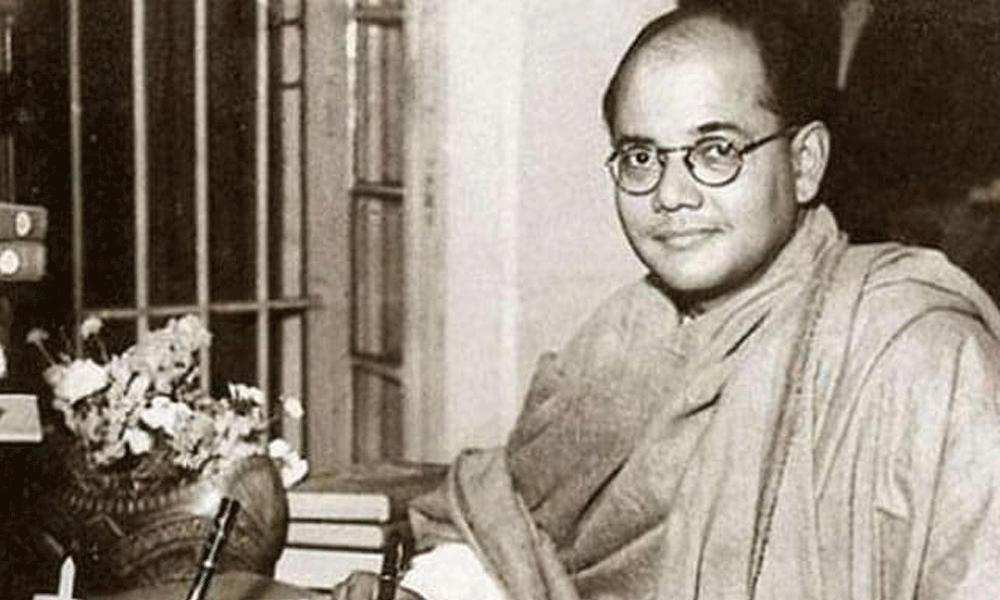
Netaji Subhas Chandra Bose. Photo : Collected
In British India, mainstream politics was led by Mahatma Gandhi, Dadabhai Nawroji, Muhammad Ali Jinnah, Jawaharlal Nehru, Ballavbhai Patel, the Ali brothers and a host of brilliant leaders since the inception of the Indian National Congress in 1886. Later, emerged other parties like the Muslim League, Swaraj Party, Krishak Praja Party and so on. They were all fighting against British colonial rule but their movements, demonstrations and agitations followed non-violent tools propagated by Gandhi.
But in the twentieth century, there emerged another distinct line of underground politics in India consisting of young freedom fighters who believed that the British could not be dislodged by non-violent movement. Bhagat Singh, Ramprasad Bismil, Ashfaqullah, Bagha Jatin, Surya Sen, Preetilata, Savarkar, Matangini Hazra and many such revolutionaries sprang up, who were not afraid to become Martyrs for the freedom of their motherland.
Netaji Subhas Chandra Bose was of this group. So, defying senior leaders, he decided to go into action with his younger and militant supporters. He completed one term as Indian National Congress President. The old guards understood his ability to mesmerise the people with his speeches of freedom by any means and his organising capabilities. The seniors were bogged down with the idea of non-violent ways of seeking and negotiating freedom from Colonial rule. When Netaji won the Congress Presidency next, he was tactfully deprived of the position. The leader understood what he had to understand. He came out of Congress to form his own Forward Bloc. Soon WW2 started. Indian politicians were demonstrating in the Quit India Movement, which was of course a proto-type non-violent one.
Still, all the notable Indian leaders were put behind bars. The backbone of the movement was broken. Then the British pleaded with the Indians to help them by joining WW2. In return, they will consider granting self-rule when they win. The Indian leaders had no option but to agree.
But not Netaji. He was different. He considered the old proverb— “Enemy’s enemy is my friend”. Acting on this axiom, he deceived the British intelligence and escaped from his police internship at his Calcutta home to Europe via Punjab, NWFP, Afghanistan and the USSR and finally landed in Germany. It was a huge accomplishment and is termed The Great Escape in Indian history.
Germany, Japan and Italy formed the Axis Forces in WW2 as against the Allied forces of Britain, France and the USA. Both Germany and Japan promised Netaji all possible help to fight the British and free his motherland India. He took that chance. Indische Legion (Indian Legion) was formed in Germany.
The backbone was Indian POWs in the custody of Axis forces in different sectors. Expatriate Indian students were other enthusiasts. They had regular military training and even ran a radio station. With the satisfactory progress of the Germans in the Far East, this Legion was planned to thrust its attacks on the western Indian front. By 1943, it appeared to be difficult as the German progress on this front was slow.
Subhas Bose changed his strategy. Both the Germans and Japanese agreed that he had a better chance of entering India from the east with Japanese help. Then ensued another protracted great feat. A German submarine brought him to the East African coast where he changed over to a Japanese one that eventually brought him to Singapore via Indonesia. In Singapore, Netaji took command of the Azad Hind Fauz. The blueprint was already laid by veteran revolutionary Rash Behari Bose, who had been residing in Japan for long and working towards Indian freedom.
From Singapore, Netaji went forward northward with his forces. Andaman and Nicobar islands were by then in the hands of Japanese forces, and as allies in the war, they supported Netaji to set up his first HQ in Indian soil in the premises of the half-destroyed infamous cellular jail in the Andaman and Nicobar islands, which Netaji promptly renamed as Shahid and Swaraj islands.
Later, Netaji left his Swaraj Dweep HQ and joined his frontline soldiers at Moirang. There was a do-or-die battle in the 200-odd km front of Manipur and Nagaland. Netaji, at some point in time, shifted to a rural setting in Nagaland to bolster his forces. Unfortunately, not all wars could be won. A hand-to-hand battle saw the Japanese defeat and their fate in this sector was sealed.
Netaji gave orders to his forces to retreat and go back to regular life, if possible, until further orders. The army suffered colossal losses while retreating. And the leader was known to have flown from Vietnam to Taipei en route to a probable USSR destination. There are various conspiracy theories about his whereabouts after 17 August 1945. Four enquiries were held so far one by the British and other three by the Indian authorities. None could come to any clear conclusion and satisfy people’s beliefs, inquisitiveness and perceptions.
Though there are many proofs that Netaji died in a plane crash at Taihoku (Taiwan), there are many others to the contrary.
Of late, a duo of enthusiastic Netaji lovers has worked meticulously for years and they have published many books on Netaji mystery. Though many have dubbed them as conspiracy theorists, they have already established themselves as scholars on the subject.
Doing a little bit of study on Netaji and visiting Faizabad and Bhagagawanji's residences, I could talk to many persons who are and were part of the process. Having done all the exercises myself, I cannot discount the theory propagated by them. But everyone has his/her own choice to decide on the whereabouts of the great leader.
On his birthday today, we salute Netaji Subhas Chandra Bose.
_________________________
The writer is a columnist

